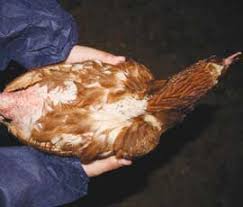Vent pecking in poultry farming can simply be defined as an abnormal behavior of birds performed primarily by commercial egg-laying hens / chickens. It is characterized by pecking damage to the cloaca, the surrounding skin and underlying tissue.
Vent pecking and cannibalism are an ongoing concern for free-range egg producers as it does not only affect their production and the general performance of the chickens, it also sometimes leads to the death of the chicken when severly affected which causes a great loss for the poultry farmer.
Meanwhile, increasing feeding related behaviour will fulfil the need of the foraging behaviour of the laying hens, which may lead to a decrease in feather pecking.
It can be fatal to the hen under attack, unless there is quick intervention. Since birds are attracted to pecking at the color red, a bird who has existing damage to her vent which causes it to bleed, or has a prolapse where red tissues are exposed, is at risk of vent pecking.
Incase you are new to poultry farming business and you are currently wondering what a vent is, a chicken’s vent is the opening where she expels waste and the opening from which she lays her eggs.

Outbreaks of cannibalism / vent pecking among poultry chickens occur in all types of housing systems, including cages, floor pens, aviaries; in outdoor, free-range flocks; and among many different types of poultry, including chickens, ducks, turkeys, quail and pheasants. Birds will show cannibalistic behavior when they are crowded or feed-restricted. Flock behavior and inter-bird dynamics often include aggression of birds toward each other, which can ultimately result in injury.
Read Also: Basic things you should know about Poultry Farming
Causes of Vent Pecking among Poultry Chickens
Vent pecking clearly causes pain and distress to the bird being pecked. It is not normal and this happens due to the following factors:
1) Stress
2) Inadequate spacing.
3) Mineral deficiency mostly protein deficiency
4) Too much or too little light (inadequate ventilation)
5) Idleness
Therefore, birds react by pecking on each other so when blood comes out, all birds attack one bird and can be pecked to death.
Ways to Control Vent Pecking among Poultry Chickens

The solution to this problem of vent pecking among chickens include but not limited to the following processes:
1) Improving on spacing with chickens properly
2) Isolate those that have been pecked and Spray the wounds with Alamycin spray.
3) You can improve on the Ventilation by opening brooder curtains during day. Portion feeds the right way so that chicks always have feeds to avoid idleness.
4) Control the amount of light that enters the brooder, mostly that from the sun.
5) Use a thermometer in the brooder because you will be able to properly regulate brooder temperatures because too much heat can lead to the same condition (due to constipation)
6) Give chicks water with glucose and Multivitamin for 30 minutes prior to feed introduction.
7) Give in water an Anti-stress after you have identified this condition in birds, it facilitates faster healing.
Read Also: Routine Activities for a Better Poultry Performance in Poultry Production
Importance of Eliminating Vent Pecking / Cannibalsm among Poultry Chickens

Cannibalism usually occurs when the birds are stressed by a poor management practice. Once becoming stressed, one bird begins picking the feathers, comb, toes or vent of another bird. Once an open wound or blood is visible on the bird, the vicious habit of cannibalism can spread rapidly through the entire flock. If you notice the problem soon after it begins, cannibalism can be held in check.
However, if the problem is allowed to get out of hand it can be very costly. Cannibalism will lower the bird’s value due to torn and damaged flesh, poor feathering and can result in high death losses. Once this habit gets out of hand it is difficult to eliminate.
Additional preventive measures of vent pecking / cannibalism among chickens include
- Allow the birds to use up their energy in an enclosed outside run. This will keep the birds busy and allow them to peck greens, ground and insects instead of other birds.
- Give the birds a large handful of fresh greens like clover grass or weeds, each day. This increases the fiber in the birds’ diet. A high fiber diet will keep the birds’ gizzard full and keeps the birds more content. Small parts of baled green leafy hay will also give the birds something to pick at.
- Use of mechanical devices like plastic peepers or blinders in aggressive birds like gamebirds is advisable.
- Placing colored or shiny items for the birds to pick at and occupy their time can draw attention away from other birds. Hanging shine cans just above eye level can serve as a toy.
- Finally, beak trimming is used in problem flocks. Trim the beak by removing about 1/3 of the tip of the beak providing a square tip. This makes it difficult for the birds to harm each other. However, beak trimming should be done by someone experienced in proper trimming.
Read Also: 7 Amazing Health Benefits of Cherries
Read Also: Adaptive Means of Animals Coping with the Environment
Read Also: 4 Amazing Foods and Drinks That Can Help You Quit Smoking
Read Also: Complete List of Popular Common Foods and their Fiber Contents

